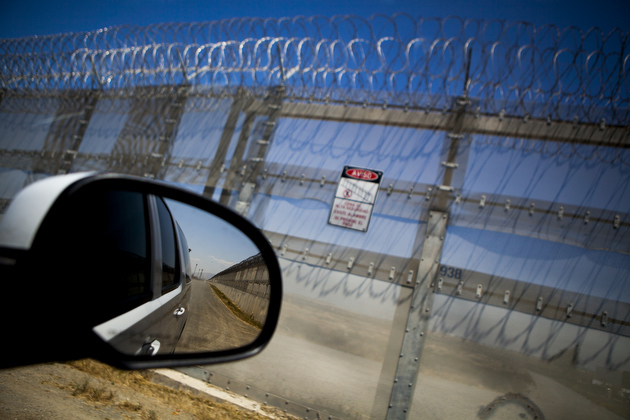San Diego is playing a starring role in President Donald Trump’s emerging plans for a border wall.
The border between San Diego and Tijuana is already home to a series of border structures, and it seems they could soon be replaced in the first phases of funding for Trump’s promised border wall.
Most of the existing structures, though, are fences. Trump’s promise has been for a concrete border wall.
As those plans move forward, some Republicans have started to argue that fences and walls are essentially the same – so people might as well get on board with the wall.
There are, of course, functional differences between the two: You can typically see and hear through fences. When it comes to the U.S.-Mexico border, a fence can actually be a security advantage, some experts say, because you can see what’s around you.
Perhaps the bigger difference is symbolic. Fences are used in communities between neighbors; walls are barriers meant to keep things separate. Virtually everyone agrees that the border wall would carry a much different meaning from what’s there now. Whether that’s a good thing is where things start to break down once more.
Here’s what we know about the fence that already exists, and the structure Trump wants to replace it.
Plans for the Wall in San Diego
Plans for the border wall that have trickled out in the media suggest San Diego is top of mind for the Trump administration.
The first $1 billion planned for the wall include several stretches in San Diego, according to CNN:
“The money will fund 14 miles of new border wall in San Diego, 28 miles of new levee wall barriers and six miles of new border wall in the Rio Grande Valley region and 14 miles of replacement fencing in San Diego. The fencing would likely include concrete elements, a source familiar with the plans told CNN.”
The Washington Post got even more specific Monday. The paper reported that a Department of Homeland Security planning document shows Chula Vista and Imperial Beach are among the cities labeled “high priority” for the wall.
“In the San Diego sector, Homeland Security chose Imperial Beach and Chula Vista as priorities for border barriers because it would be easier to build on the region’s federally owned land, the planning document said.”
That came as a surprise to Gary Halbert, Chula Vista’s city manager. Halbert pointed out that even the parts of Chula Vista that are closest to the border are still about four miles away.
“I can’t imagine where they would be thinking,” Halbert said.
Imperial Beach Mayor Serge Dedina said he wasn’t aware of the federal government’s plans for his city, either.
“Our section is only about half a mile. I don’t know what they’re doing, unless they’re replacing part of it,” he said.
Before it gets any actual segments of border wall, San Diego will host the first look at prototypes of the structure.
After the federal government narrows the companies competing to build the wall down to 20 vendors this summer, those selected will build prototypes in Otay Mesa.
The whole thing could be facing another delay before it really gets started, too. Media reports late Monday suggested Trump was willing to push the funding fight for his wall until the fall, possibly taking a government shutdown over the issue off the table.
The Structure We Already Have
Before many Republicans came on board Trump’s plans to build a wall separating the United States and Mexico, they were on board with the existing structure separating two countries, the border fence.
Indeed, the United States has spent the last two decades or so building new stretches of fence and reinforcing existing portions.
The Illegal Immigration Reform and Immigrant Responsibility Act of 1996, signed by President Bill Clinton, and the Secure Fence Act of 2006, both committed the United States to beefing up border fencing. Thanks to those pieces of legislation, much of San Diego’s border with Mexico is separated with what’s referred to as secondary fencing, or two fences.
A few areas have even more fencing than that, Lisa Halverstadt found in 2013. There’s a roughly one-mile stretch, for example, along the Tijuana River Valley, that has four fences.
“Border Patrol officials say that area wound up with four fences because a curve in the Tijuana River Valley places the U.S.-Mexico border at an awkward angle — it’s not there to quadruple security. They opted to put up extra fencing to deal with the odd configuration.
… There are a few other spots with multiple fences, including an area near the infamous Smuggler’s Gulch, where chain link fences mark the intersection of federal, state and local land.”
At a House Homeland Security Committee meeting in February, some experts testified that a fence has security advantages over a wall, “because agents could more easily see across the border,” according to CNN.
Semantics and Symbolism
San Diego officials on both sides of the debate agree on one thing: that the existing border fence already separates the region from Mexico.
Republicans increasingly are using this fact to dismiss opposition to the wall as disingenuous, because people are largely OK with the structure that is already there.
On Friday, the two Republican members of San Diego’s congressional delegation both suggested the border fence and a border wall were interchangeable. Rep. Darrell Issa said that by voting for measures that included funding for the border fence, Democrats have “already voted for a wall.” White House budget director Mick Mulvaney made the same argument over the weekend. Rep. Duncan Hunter said Friday that he supports a wall, and that people could “call it whatever” they want – insinuating that the only difference between a fence and a wall was the words themselves.
Many San Diego leaders opposed to a wall have said that aside from it being a duplicative and unnecessary structure, they don’t sign on to the symbolism.
“I think it is a spite wall,” Rep. Juan Vargas, whose district runs along the border, said Friday.
“The border wall is a symbol of bigotry, divisiveness and waste that goes against California’s values,” Assemblywoman Lorena Gonzalez Fletcher, whose district overlaps with Vargas’, said in a statement Friday.
What the State’s Doing to Stop It
Gonzalez Fletcher is among a group of progressive Democrats at the state level trying to beat back Trump’s immigration policies, including construction of the wall.
She is joint author of a bill that would require the state’s pension funds to divest from companies involved in the construction of border wall. Another bill, written by state Sen. Ricardo Lara, would prevent companies or individuals involved in building the wall from receiving state contracts.
Lt. Gov. Gavin Newsom has suggested that California’s landmark environmental law, CEQA, could be a foil for the border wall. But legal experts have said that’s not all that likely.
An earlier effort to stop construction of a third layer of border fencing using environmental laws failed.
San Diego attorney Cory Briggs, who represented several environmental groups in the case, said that there may be ways to block the border wall in court but that invoking CEQA isn’t one of them.
That’s because “federal law ‘trumps’ state law on issues that are exclusively federal, such as protecting our borders,” Briggs told VOSD. “We lost the last border-fence lawsuit because presidents, starting with Clinton, were given broad authority by Congress to waive federal laws that would have given the state some leg to stand on. … If the feds try to do this cooperatively and give California incentives to cooperate, then CEQA would apply to state decision-making. But if the feds use the tools available to force the issue and have the necessary funding, then there’s nothing CEQA or any other state law will do.”
Ry Rivard and Maya Srikrishnan contributed to this report.





